My mom taught me a neat trick when I went to college: Take the leftover veggies from dinner, chop some fine onion, add some hot sauce, and use it as your sandwich spread.
I used the hack all the time — sometimes for breakfast on busy mornings and other times for snacking in late evenings. I was always surprised at how different yet familiar the sandwich tasted.
That’s what content repurposing is, in a nutshell: You take yesterday’s existing content and use it to whip up new content for today. Just like my sandwich did for me, it’ll save you hours you would’ve spent creating something new from scratch.
And the benefits of repurposing content exceed above and beyond time-saving. In the digital marketing world, content repurposing:
- Helps you expand your content’s reach (because you share it multiple times in more than one format to new audiences)
- Enables you to create more content without burning out (because you don’t have to use brainpower to think of a new idea)
- Boosts your SEO efforts (friendly for search engines because you’re creating multiple content pieces targeting similar keywords)
But what most of us struggle with is practicing repurposing content regularly. It doesn’t become a part of workflows so easily, and it’s often more difficult than it looks.
In this article, I’ll first answer some of the most common questions related to content repurposing to help you make it a non-negotiable part of your working process. Then, I’ll share various ways of repackaging various types of content — from long-form articles to short-form videos. Let’s go! 👇
5 FAQs about content repurposing answered
1: How is repurposing content different from cross-posting and reposting content?
The commonality? All three (cross-posting, reposting, repurposing) are ways to reuse your existing content.
Cross-posting is when you share a piece of content as-is on another social media platform. For example, you can post your TikTok video as an Instagram Reel and a YouTube Shorts video without changing anything since they are similar content types. Creator Laura Whaley does this regularly with her TikTok, Instagram, and YouTube.

Reposting content is when you republish a piece of content on the same platform. For example, you repost a writeup on X (formerly Twitter) that previously got a ton of engagement and positive response from your audience. For example, Katelyn Bourgoin posted a timeless advice on X in 2020 and repeated it in 2021, also on X.

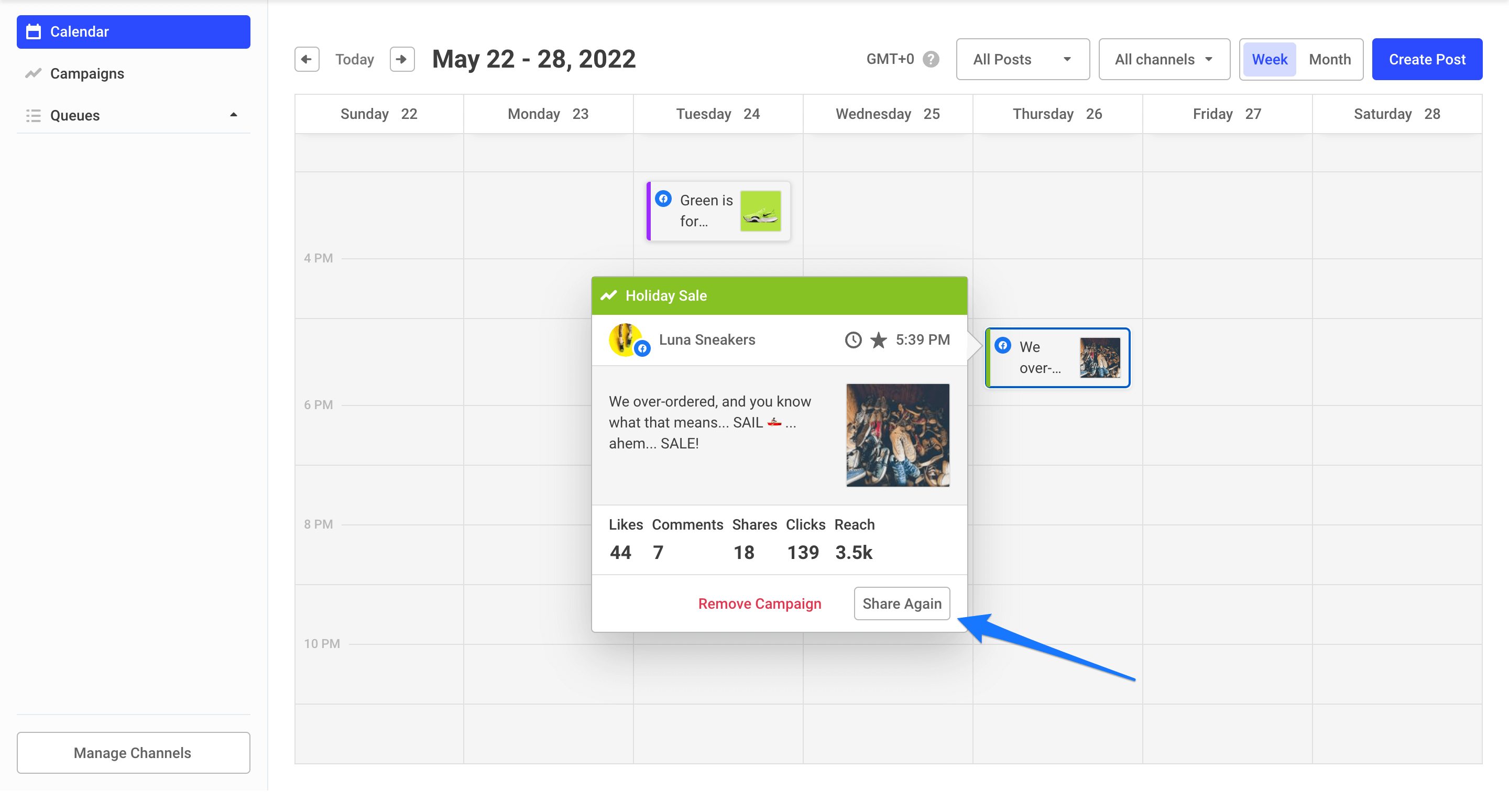
Repurposing content is keeping the crux of a piece’s idea and adapting it for other social media channels. For example, you distill high-performing old blog posts into Instagram carousel posts.
At Buffer, we regularly repurpose content — and one of our core strategies is turning our blogs into social media posts. For example, we turned this blog post on creating content pillars into an Instagram carousel (and even a thread on X!).
The difference is minute but crucial:
- Cross-posting is posting the same piece of content on various platforms
- Reposting is posting the same piece of content again on the same platform
- Repurposing is repackaging a piece of content into different content types
In your social media marketing strategy, you need all three.
Why? Cross-posting saves time, reposting helps you double down on your success, and repurposing content helps you with content distribution.
Here’s how you should approach the three methods:
- Cross-post content across social media channels wherever you can
- Monitor the posts getting the most reach and schedule them to be reposted after a certain time period
- Bake repurposing into your content creation workflow and post the same piece of content in various formats and channels
2: When should you think about repurposing content?
It depends.
Do you already have a ton of content backlog?
Then, you should start thinking about content repurposing immediately. Repackage those old pieces (begin with the popular posts) to get more value out of them.
Are you new to content creation (for social media or in general)?
Then, try to embed content repurposing into your workflow. For instance, you could make it a task to turn every YouTube video you create into short-form videos for Shorts, Reels, and TikTok. This way, you get ahead of the game and don’t wait till you don’t get enough organic engagement to think about content repurposing.
Are you breaking into a new channel or platform?
Then, start content repurposing right away. Most channels and platforms will give you an advantage if you post more frequently. To publish at a higher cadence, take the content you already have on other channels and repurpose it for the new platform.
For example, if you’re trying to grow on Instagram Threads, you can easily repurpose (or even cross-post!) content you posted on X since both platforms allow for a similar type of content.
Read more: 8 Social Media Content Ideas to Incorporate into Your Strategy
2a: Should you repurpose only old content?
If you have an up-to-date content backlog, don’t limit yourself by repurposing only old content. Make content repurposing a part of your workflow for new posts too.
This way, old posts will continue getting repurposed, and you’ll not accumulate more recent posts in your “needs to be repurposed” pile. Sprinkle the old repurposed and the new repurposed strategically across your content calendar.
2b: Should you repurpose only evergreen content?
Yes and no.
You can’t repurpose time-sensitive old pieces.
For example, if you’re launching a new product line, repurpose it across all platforms as soon as possible. It's news that’ll get old fast. If it’s already been more than a month since the launch, you can’t repurpose a “new” launch post.
(This is why we’re advocates of embedding repurposing with content creation itself. It ensures no piece goes stale without getting repurposed.)
You can repurpose irrelevant old content after refreshing it.
For example, if you’re trying to repurpose a post on a work-related topic pre-pandemic, you need to first update it with the info and happenings of the post-pandemic world. Once refreshed, you can repurpose it (even if it isn’t “evergreen”) — because it’ll be relevant to your audiences today.
3: How do you prioritize which content you should repurpose?
In an ideal world, we’d repurpose our old and new posts simultaneously at scale — without burning out. Either we’d have the mental capacity and time, or we’d have the team to accomplish something of this scale.
But in reality, it’s challenging to determine what should be your primary focus. Should you concentrate on repurposing your old content backlog fast? Or should you put the spotlight on repurposing newly published content first?
There’s no one correct answer. What you should prioritize depends on your goals with content repurposing.
For example, if your goal with content repurposing is to pump new life into pieces that are losing traffic, your priority should be repurposing your old posts. But if you aim to build brand awareness and expand your reach, your focus should be repurposing posts that went live more recently.
4: How do you make content repurposing a seamless part of your workflow?
The easiest way to bake content repurposing in your current workflow is to think about it at the content creation step itself — like Chima Mmeje, Senior Content Marketing Manager at Moz:
“I start thinking about repurposing opportunities from the moment I'm reviewing a content brief. It's a strategic part of content creation, with an eye on lifecycle and future engagement. I consider the desired metrics and target audiences, understanding where they spend their time online to inform our repurposing strategy. For instance, our recent post on AI for SEO serves as a stellar example of digital asset spin-offs; it's been repurposed into an engaging OG image, capitalizing on X’s (formerly Twitter) new link preview format to make a stronger visual impact.”
Let’s say you run an active long-form blog and an Instagram account. When you’re crafting blog content, keep your Instagram channel top of mind:
- How can you structure your article so it’s easy to read on your website and as an Instagram Carousel post?
- What is the information in your blog that can make for an engaging Instagram Reel?
- What information from your blog can you use to create an interactive Instagram Story?
- Can you turn your blog into a slideshare presentation for an Instagram Live broadcast?
- Which graphics from your article will make for an excellent in-feed post?
You can keep a goal to create at least five mini posts out of every long post — whether video or written. Keeping repurposing at the center of content creation ensures you don’t have to spend many hours repackaging posts to be friendly for another channel or platform.
At the end, scan your fresh post again. Challenge yourself to find even more ways to repurpose it for other social or content marketing channels you use.
5: Should you repurpose your content for every channel?
No.
Repurpose your newly-created or old content only for the channels you’re already active on or the channels you’re trying to build a community on. Content repurposing is a low-lift way of boosting your online presence. But that doesn’t translate to being active and present everywhere.
Justin Simon, Content Distribution Consultant for B2B SaaS and Creator of Content Repurposing Roadmap, agrees:
“The two biggest mistakes are assuming you need to repurpose content into dozens of formats and then share it on every platform possible. Both of these mistakes will hold you back. The best thing you can do is create a repurposing plan that you will stick to. Even if that means creating only two types of content and distributing on a few key channels. Executing fewer things consistently will drive way more growth than if you try to do all the things at once and get burned out.”
Don’t become active on different platforms just because you can repurpose content for them. Think:
- Is your target audience even present on the new channel?
- Do your customers like to hear from you on this platform?
- Do you and your team have the bandwidth to create a mix of native and repurposed posts for this new channel?
Only introduce a new platform into the mix when it can give you enough return on investment and when you have the capacity to develop your audience on another channel.
With those doubts cleared, let’s dive into the nitty-gritty of what repurposing looks like in action.
5 ways to repurpose long-form written content
Long-form written content includes blog content, ebooks, research reports, whitepapers, and case studies. These are great for repurposing because they have a ton of insights that you can repackage into various formats.
1: Convert your ebooks & research reports into blogs
The first one is the simplest: Repurpose your existing long-form content to another long-form content. For example, you can turn the various chapters of your ebook into blogs of their own. Or you could repurpose snippets from your research report into a blog.
The company Influencer Marketing Hub does this regularly. They have a “State of Influencer Marketing” Report released every year. They repurpose this report into an article of its own — sharing only the key statistics from the whole report.

2: Convert snippets from your long-form content into X & LinkedIn posts, newsletters, and community responses
Long-form written content has a ton of information. From each piece, you can create multiple posts for X (formerly Twitter) and LinkedIn — because both social media platforms are text-friendly.
We do this regularly at Buffer by creating a post on LinkedIn and X for every long-form blog we publish. For example, we recently talked about pivoting your personal brand in an article and revamped that post for LinkedIn.

Similarly, you can share snippets from your long-form content in your newsletter, Facebook Groups, Reddit, or Quora. For instance, SparkToro regularly shares snippets of their articles (like this one about high-quality content) in their newsletter.

3: Convert snippets from your long-form content into Instagram and Pinterest infographics
Creating visual assets from written content isn’t as easy as repurposing it into another text-friendly format. Still, it’s worthwhile if you have a presence on a visual social media channel like Instagram or Pinterest.
For instance, we recently converted our blog post about AI prompts into an Instagram Carousel post for Instagram.

4: Convert your long-form content’s insights into a YouTube video or an Instagram Live broadcast
You can present your long-form content as a video on YouTube and Instagram, too. For example, HypeAuditor collaborated with an influencer marketing expert — Gordon Glenister — for a YouTube live webinar on their 2023 State of Influencer Marketing report.

The best part? From your long-form video, you can create various short-form videos for other social media channels — further extending the reach of your original long-form written piece.
5: Convert snappy takeaways from your long-form content into Instagram Reels or TikTok videos
You can convert the takeaways from your long-form piece into an Instagram Reel or a TikTok video, too. Not every written piece can be distilled into a short 15 to 60 second clip, but if it has clear takeaways — and you’re active on Instagram or TikTok — give it a shot and see how your audience likes it.
We do this ourselves at Buffer by sharing Instagram Reels about our blogs. For instance, we narrated the critical insights from our personal branding framework into a Reel.
5 ways to repurpose long-form video content
Long-form video content isn’t limited to your YouTube channel. It also includes any webinar, tutorial, video podcast episodes, or live broadcasts you do. Since these videos are long and jam-packed with useful intel, you can repurpose them into various formats easily.
1: Convert your long videos into short-form videos
The easiest way to get more out of your long-form videos is to convert them into various short-form videos. YouTube has YouTube Shorts, Instagram has Reels, and TikTok has videos. Cut your long video into various interesting snippets and share it across different platforms for an added engagement boost.
Creator Cleo Abrams does this regularly. Look at how she created an Instagram Reel from her YouTube video and encouraged her followers to watch the whole thing.
And don’t think you can’t do this if you aren’t active on YouTube, Instagram, or TikTok. LinkedIn and X also love video content. Modash, for example, regularly cuts its video podcasts into posts for LinkedIn.
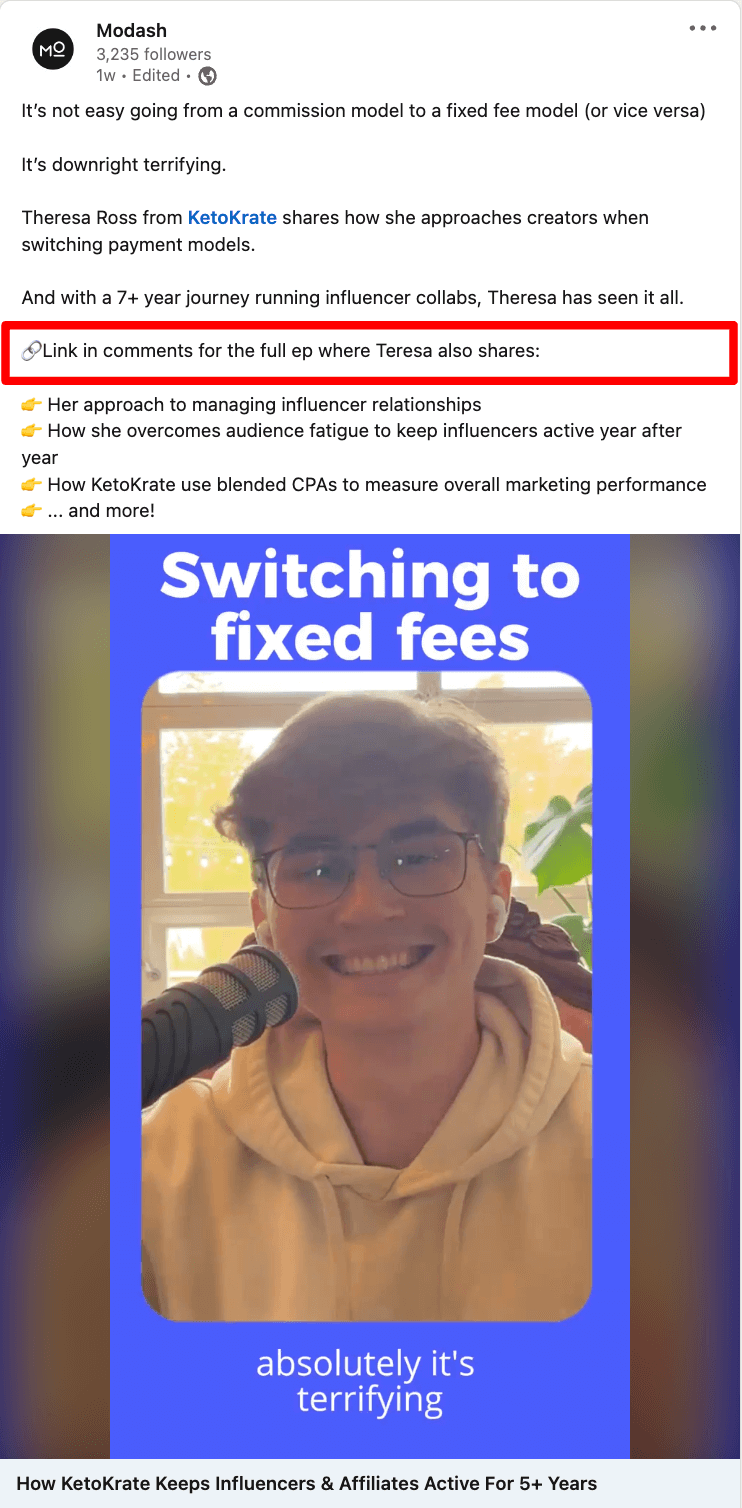
Whatever platform you’re on, edit every long-form video into various short-form video snippets.
2: Convert snippets from your video into written insights for blogs, newsletters, and social media
You can use insights from your long-form video as insights for social media posts, blogs, and newsletters.
For example, Justin Simon wanted to promote the latest podcast he was on. But he didn’t just type a promotional post about, “this was a blast. watch this!” and call it a day. He took it a step further and repurposed an insight he shared on the video podcast with text and a video snippet on LinkedIn. The post stands alone on its own, too — which is the magic of content repurposing. He left a comment as a call to action to watch the whole podcast.
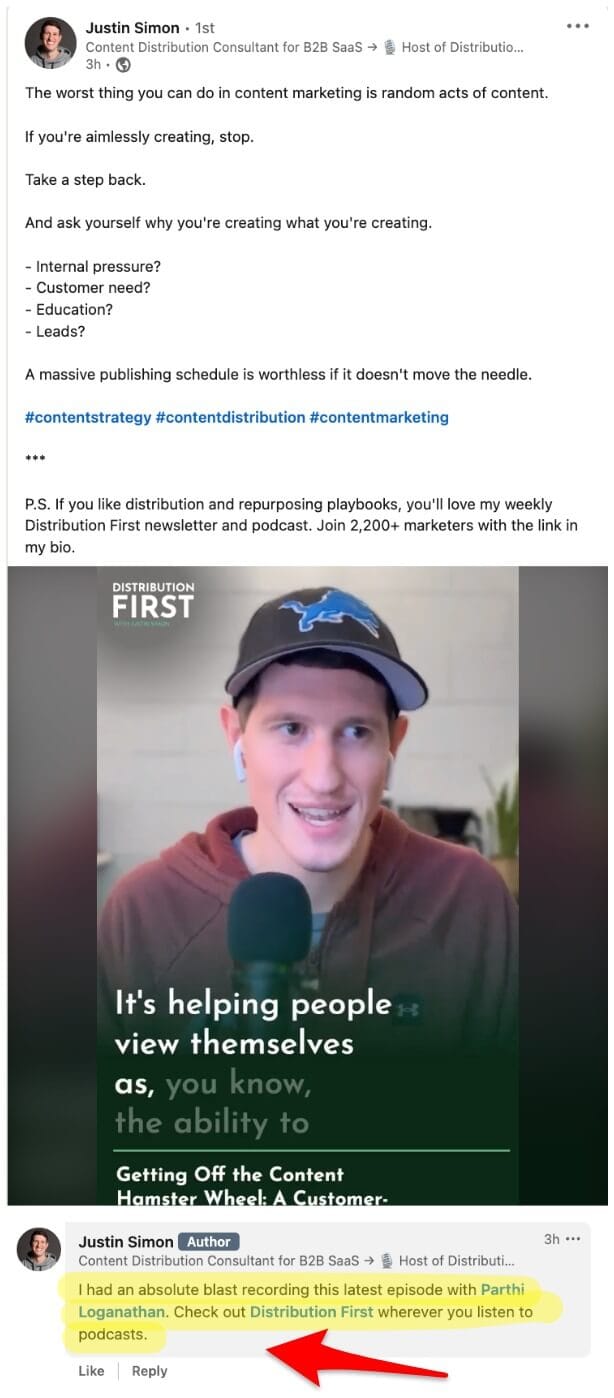
3: Convert your video into a blog
Just like you can convert your long-form content into a long-form video, you can convert your videos into a blog.
For example, Ahrefs’ YouTube channel published a video about ChatGPT for SEO in February 2023. Later in May, they published an article on the same topic and embedded the video inside it.

This not only boosts your content’s reach by publishing it in various content formats across multiple channels — but also allows you to provide your audience with their preferred mode of consuming your content.
4: Convert your long video into an audio podcast
If you have a video that’d also fit as an audio podcast, you can repurpose it by releasing audio-only versions on Spotify, Apple Podcasts, and more.
For example, Tommy Walker used to host live editing sessions with content marketing experts on his YouTube channel. Once he realized the demand for audio-only podcasts, he converted these videos into that format.
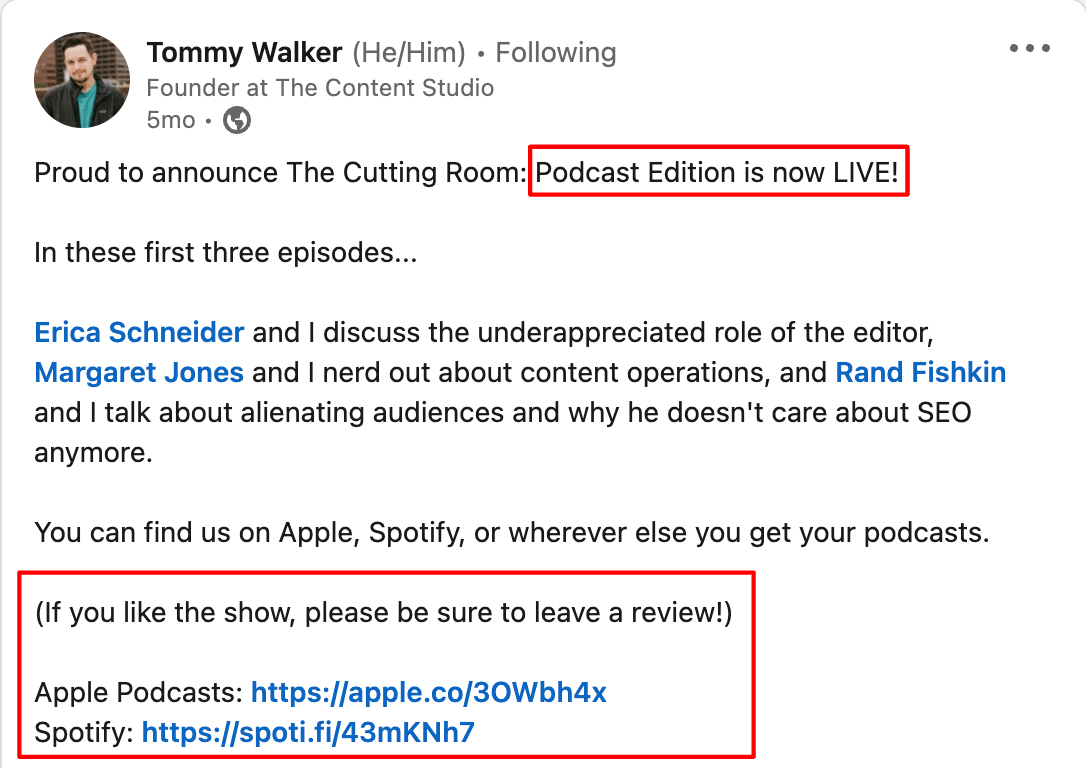
Suppose you have a long-form video like a webinar, tutorial, or interview that works without your audience seeing anything on their screen. In that case, you can convert it into an audio format.
5: Convert images from the video into shareable images for social media
This repurposing method won’t work for every video, but it will work for videos where you use a lot of static images. Take YNAB — they redesigned their product with new colors and wanted to take a trip down memory lane with their audience.
They shared a YouTube video about the change — highlighting the various designs they’ve had in the past. Then, they repurposed the video into an Instagram Carousel post containing the same images used in the video.
If your videos also contain a presentation or static images, use those as visual assets to post on other social media channels. You repurpose your original post and promote it, too — win-win.
Read more: What to Post on Instagram: 19 Examples from Small Businesses That You Can Make Your Own
3 ways to repurpose social media content
Social media content includes everything from a LinkedIn post to a TikTok video.
1: Convert threads and long-form posts on X into a LinkedIn post (or vice-versa)
X (formerly Twitter) and LinkedIn are sister social media platforms. Whenever you write a LinkedIn post or a long-form post on X, repurpose it for the other channel.
Many people cross-post across these two platforms, but I’d advise shifting the phrasing, hook, and content to meet the varying needs of both channels. For instance, X needs a stronger opening sentence than LinkedIn, while LinkedIn needs more structure than a thread on X.
Chima Mmeje nails this. Look at how she repurposed her LinkedIn post about AI into a thread on X (formerly Twitter) by slightly tweaking the hook and the structure.
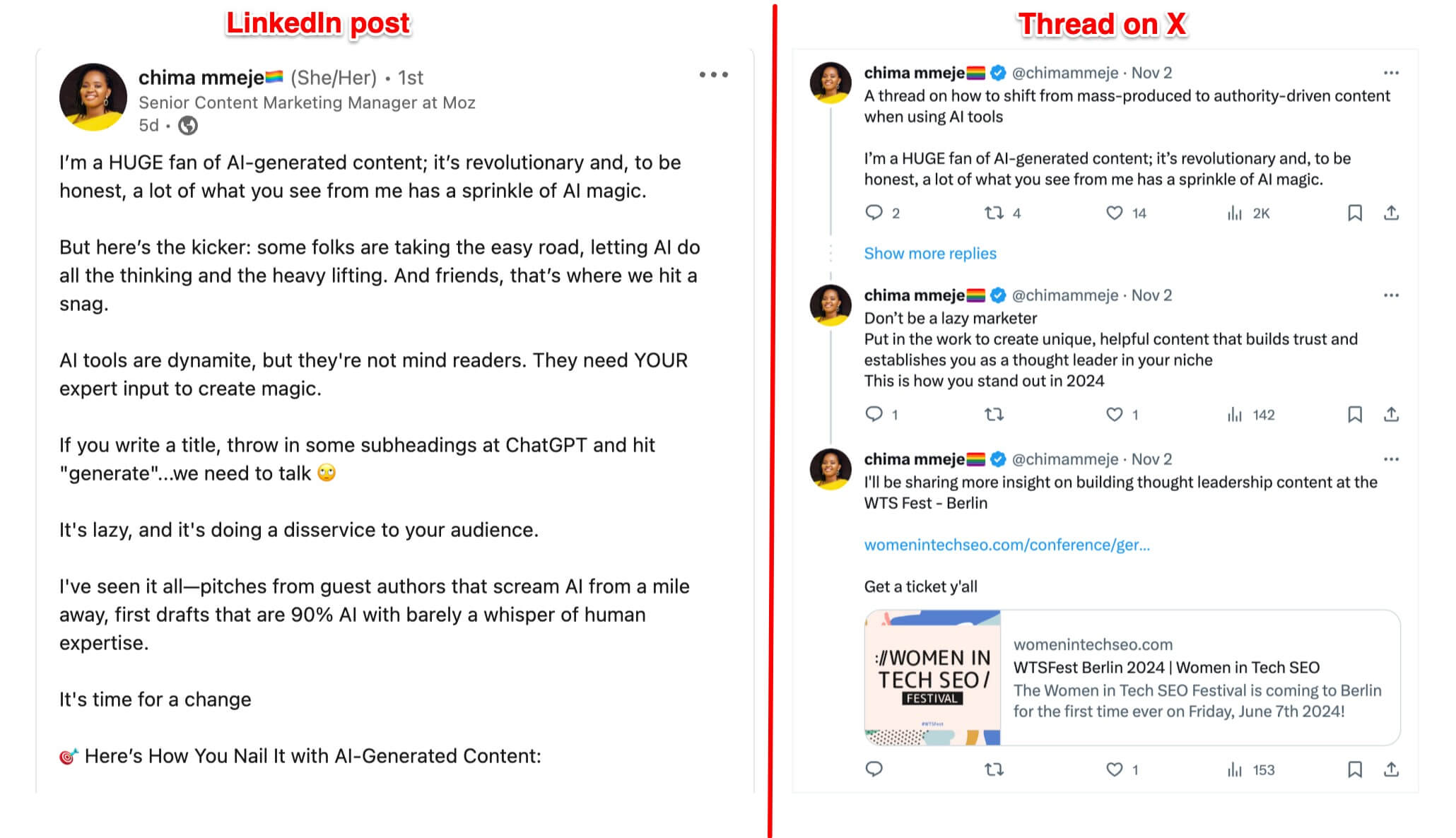
2: Convert your threads on X into an Instagram Carousel (or vice-versa)
If you can jazz up your threads on X a bit into cool graphics, you’ve got yourself an Instagram carousel (or in-feed) post.
It’s super easy to do with Canva. All you have to do is select a template and customize it with your brand colors — and you’re done!
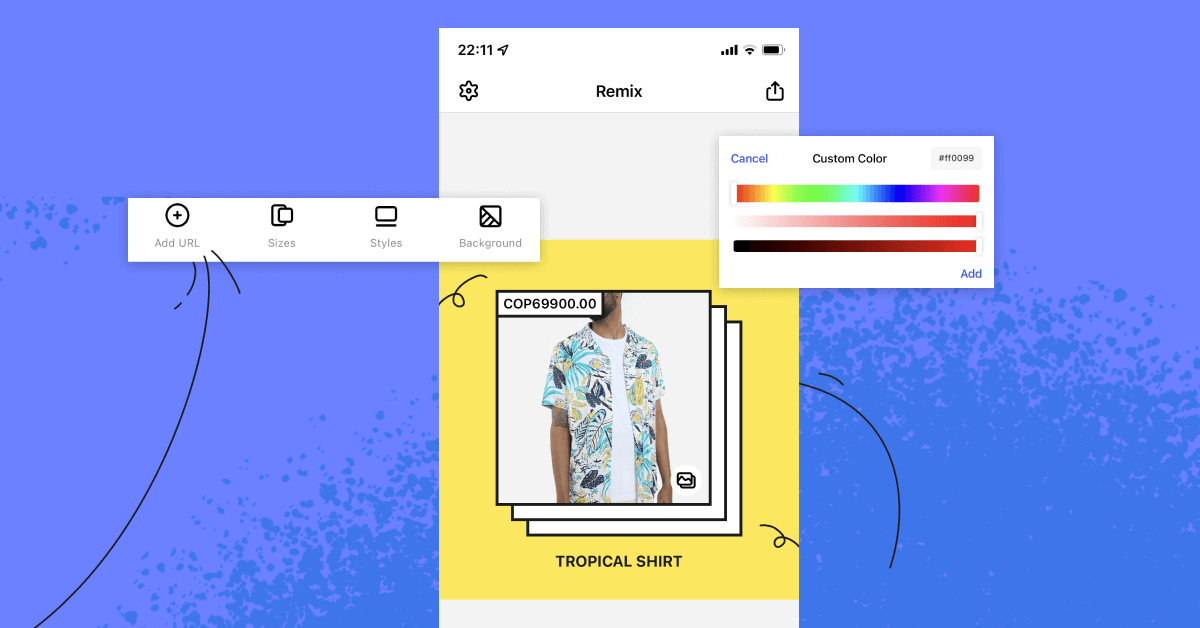
3: Convert Instagram Reels & TikTok videos on the same topic into a long-form video
You likely publish various types of posts around the subtopics within your social media niche. If you’re active on Reels, Shorts, or TikTok, you can combine short-form videos around the same niche topic and convert them into long-form YouTube videos.
Entertainment channels do this often. Take The Graham Norton Show — it combined various clips from the interviews with Emily Blunt to create a new (repurposed) video.
3 ways to repurpose newsletter content
Most subscribers expect your email newsletter content to be exclusive to their inbox. I’d recommend repurposing and sharing your newsletter content in bits and pieces after the original issue has already been sent to your audience.
1: Convert snippets from newsletters into posts for X and LinkedIn
Take your newsletter's most gripping hooks and insights and turn them into social media posts for X and LinkedIn. Both are text-heavy platforms, just like your newsletter — so repurposing will be quick and efficient.
John Bonini does this often with his newsletter, Some Good Content. He published a newsletter about the most defensible content strategy, which he later repurposed into a LinkedIn post.
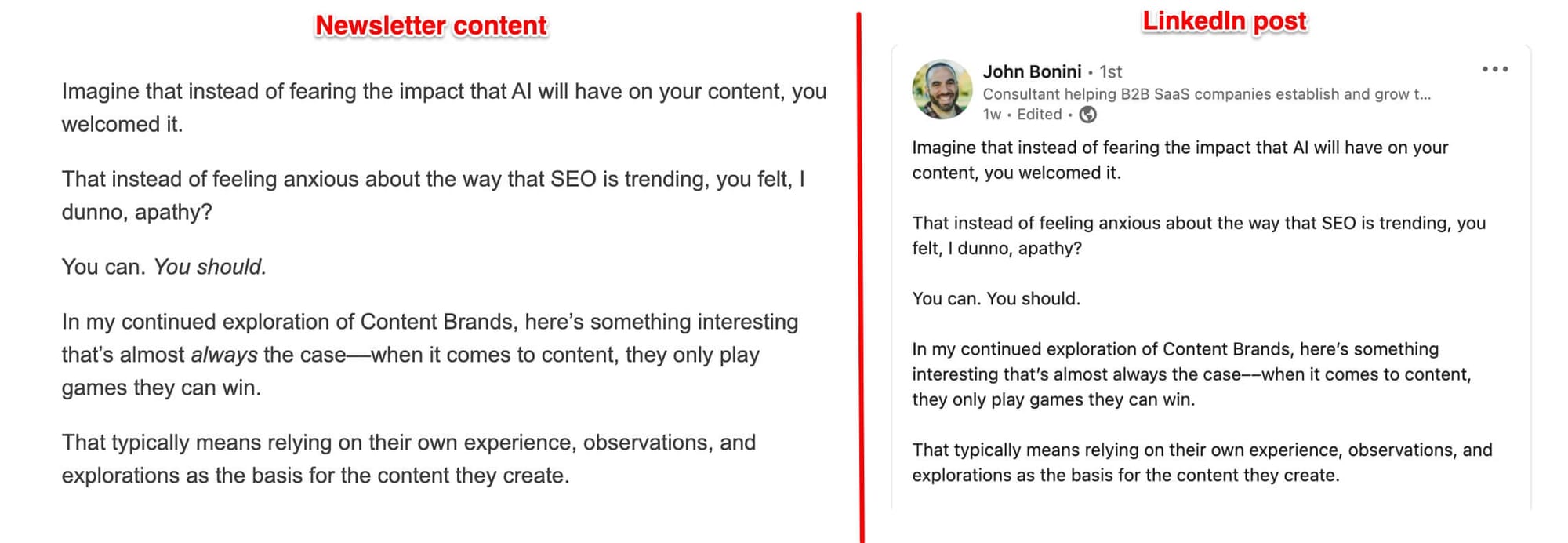
Many small businesses follow this repurposing strategy because it’s easy to implement and quick to boost engagement. The only thing critical to remember is to adjust the content into a new format that matches the platform.
2: Convert insights from your newsletter into shareable images for Instagram and Pinterest
Repurposing newsletter content doesn’t have to stay limited to text-related social media platforms. What if you could turn them into shareable graphics?
Splainer does this as a part of its digital marketing strategy. They publish a daily newsletter about the world’s news and turn it into graphics for their Instagram account. For instance, they recently had a newsletter issue mentioning Elon Musk’s AI chatbot, Grok, which Splainer repurposed into an Instagram Carousel post.

If you chose this route, go beyond posting screenshots of your newsletter. Add some life into the images via colors and graphics (like Splainer did).
3: Convert sections from your newsletter into short-form videos for Instagram Reels, TikTok videos, and YouTube Shorts
If your newsletters are structured in the same format every time, you can also experiment with repurposing them into short-form videos.
For example, The Know publishes a daily newsletter sharing only good news with their subscribers. They repurpose this content daily into a short-form video for Instagram Reels by reading the news in a listicle format. See how they recently repackaged a segment of their daily news into an Instagram Reel.
It’s not as in-depth, but it does a great job of keeping up their Instagram reach and promoting their newsletter.
Be eco-friendly with your content
Repurposing is all about content recycling. You don’t burn yourself out by constantly trying to come up with new ideas, and you get the maximum out of each piece of content you decide to publish. It’s a win-win scenario.
Aim to repurpose at least five social media posts from every long-form piece of content. And you don’t have to “remember” to repurpose. Make it a part of your content creation workflow, repurpose, schedule using Buffer, and you’re done!
Try Buffer for free
190,000+ creators, small businesses, and marketers use Buffer to grow their audiences every month.


